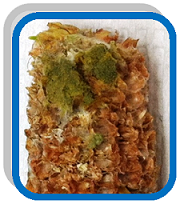 The extreme heat and drought conditions in Indiana this summer have made the corn crops more susceptible to Aspergillus ear rot growth. Aspergillus flavus mold, which is typically yellow-green or olive-green in appearance, can produce aflatoxins. These toxins can cause liver damage, immunosuppression, slow growth, and poor feed conversion in animals exposed to contaminated feedstuffs.1 It is important to remember that observation of mold on corn or other grain does not necessarily mean that aflatoxins are present; however, it can indicate potential for aflatoxin production. Likewise, the absence of visible mold growth does not imply that the corn or grain is free of aflatoxins. Screening corn samples using a black light (UV light) to look for bright green-yellow fluorescence in damaged corn kernels is sometimes used by facilities and grain mills as a presumptive test for aflatoxin. Fluorescing samples may indicate the presence of kojic acid, a secondary metabolite produced by Aspergillus fungi. Caution must be taken using this procedure as kojic acid will degrade with drying time and high levels of aflatoxins in corn and grain are not linked to the production of kojic acid.1 Therefore, it is important that the corn or grain be submitted to a laboratory for testing. Approximately 10% of the total sample submissions to the Toxicology Section thus far have tested positive for aflatoxin. These levels vary from trace amounts (≤ 1ppb) up to approximately 2,500 ppb. In order to maintain a good margin of safety for animal health, it is important to have the feedstuff tested, to store grain at less than 13% moisture, and to ensure that the corn or grain is being fed to animals/livestock below the action levels established by the U.S. FDA. For a list of the action/guidance levels for aflatoxins in animal feed, see Table 1 below.
The extreme heat and drought conditions in Indiana this summer have made the corn crops more susceptible to Aspergillus ear rot growth. Aspergillus flavus mold, which is typically yellow-green or olive-green in appearance, can produce aflatoxins. These toxins can cause liver damage, immunosuppression, slow growth, and poor feed conversion in animals exposed to contaminated feedstuffs.1 It is important to remember that observation of mold on corn or other grain does not necessarily mean that aflatoxins are present; however, it can indicate potential for aflatoxin production. Likewise, the absence of visible mold growth does not imply that the corn or grain is free of aflatoxins. Screening corn samples using a black light (UV light) to look for bright green-yellow fluorescence in damaged corn kernels is sometimes used by facilities and grain mills as a presumptive test for aflatoxin. Fluorescing samples may indicate the presence of kojic acid, a secondary metabolite produced by Aspergillus fungi. Caution must be taken using this procedure as kojic acid will degrade with drying time and high levels of aflatoxins in corn and grain are not linked to the production of kojic acid.1 Therefore, it is important that the corn or grain be submitted to a laboratory for testing. Approximately 10% of the total sample submissions to the Toxicology Section thus far have tested positive for aflatoxin. These levels vary from trace amounts (≤ 1ppb) up to approximately 2,500 ppb. In order to maintain a good margin of safety for animal health, it is important to have the feedstuff tested, to store grain at less than 13% moisture, and to ensure that the corn or grain is being fed to animals/livestock below the action levels established by the U.S. FDA. For a list of the action/guidance levels for aflatoxins in animal feed, see Table 1 below.
Table 1. FDA Action/Guidance Levels for Total Aflatoxins in Livestock Feed2